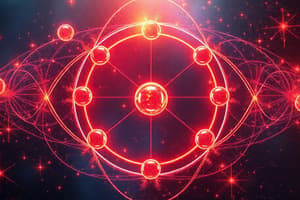Podcast
Questions and Answers
What determines the chemical properties of an element?
What determines the chemical properties of an element?
- Electron configuration (correct)
- Ionization energy
- Atomic mass
- Atomic orbitals
What is the energy required to remove an electron from an atom in its ground state?
What is the energy required to remove an electron from an atom in its ground state?
- Electron configuration
- Ionization energy (correct)
- Electronegativity
- Electron affinity
What is the shape of the s orbital?
What is the shape of the s orbital?
- Complex
- Spherical (correct)
- Dumbbell
- Four-leaf clover
What happens to ionization energy across a period from left to right?
What happens to ionization energy across a period from left to right?
What is the purpose of hybrid orbitals?
What is the purpose of hybrid orbitals?
What is the capacity of p orbitals?
What is the capacity of p orbitals?
Flashcards are hidden until you start studying
Study Notes
Electron Configuration
- The arrangement of electrons in an atom, which determines the chemical properties of an element
- Described by the Aufbau principle, Pauli's Exclusion Principle, and Hund's Rule
- Electron configuration is written in a shorthand notation, such as 1s2 2s2 2p6 for Ne (Neon)
- Energy levels (shells) are divided into subshells (s, p, d, f) with specific capacities
- Valence electrons are the outermost electrons involved in chemical bonding
Ionization Energy
- The energy required to remove an electron from an atom in its ground state
- Measured in kJ/mol (kilojoules per mole)
- Ionization energy increases:
- Across a period (left to right) due to increasing nuclear charge
- Down a group (top to bottom) due to increasing atomic size and shielding
- First ionization energy is the energy required to remove the first electron, subsequent ionization energies are for removing additional electrons
Atomic Orbitals
- A mathematical description of the distribution of electrons within an atom
- Orbital shapes: s (spherical), p (dumbbell), d (four-leaf clover), f (complex)
- Orbital types:
- s orbitals: spherical, symmetrical, and can hold up to 2 electrons
- p orbitals: dumbbell-shaped, oriented along x, y, and z axes, and can hold up to 6 electrons
- d and f orbitals: more complex shapes, and can hold up to 10 and 14 electrons, respectively
- Orbitals are combined to form hybrid orbitals, which are used to describe molecular bonding and shape
Studying That Suits You
Use AI to generate personalized quizzes and flashcards to suit your learning preferences.




